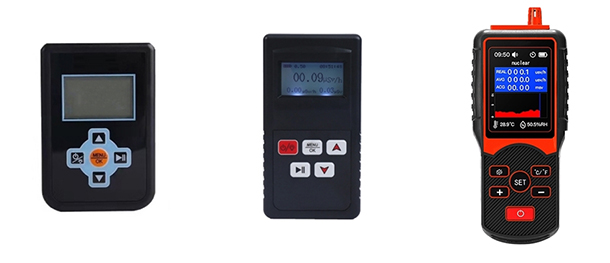What is the Nuclear Radiation Detector?
A nuclear radiation detector is a specialized instrument used to detect and measure early nuclear radiation and residual nuclear radiation from nuclear explosions. Nuclear radiation detectors typically consist of detection media, measurement components, display components, and a power source. They are used for nuclear radiation detection during wartime, assessing radiation exposure to the human body, or potential acute radiation injuries in order to take protective measures. Modern equipment for nuclear radiation detection includes gamma ray indicators, gamma ray alarms, gamma dose rate meters (exposure rate meters), beta and gamma radioactive contamination detectors, radiation meters, and dosimeters, among others.
Components used for detecting nuclear radiation based on the ionization effect, luminescence phenomenon, or physical and chemical changes caused by nuclear radiation in gases, liquids, or solids are called nuclear radiation detectors. So far, there are various types of nuclear radiation detectors used for different applications, each with its unique working principle. The information provided by detectors can directly or indirectly determine parameters such as the type, energy, intensity, or nuclear lifetime of nuclear radiation. The ATO store offers a variety of nuclear radiation detectors, welcome to visit.

Introduction
Nuclear radiation detector, also known as nuclear detection element, is a device used for detecting radiation. Common types include ionization chambers, Geiger-Muller counters, scintillation counters, nuclear emulsions, solid-state nuclear track detectors, and semiconductor detectors, among others.
These detection elements can measure radiation and its properties. Their principles primarily rely on the various effects produced when particles interact with matter. For example, ionization chambers, Geiger-Muller counters, and alpha track detectors are based on the ionization principle resulting from the interaction of charged particles with matter. Scintillation counters are made based on their fluorescent properties. Nuclear emulsions and solid-state nuclear track detectors utilize chemical reactions caused by ionization and excitation. In the case of neutral particles like gamma rays, they undergo interactions such as the photoelectric effect, Compton scattering, or electron-positron pair production, which transfer some or all of their energy to orbital electrons, leading to ionization or excitation.
Radiation detectors use an appropriate detection medium as the material that interacts with the particles. They transform the ionization or excitation produced by particles in the detection medium into various forms of information that can be directly or indirectly perceived by humans.
Performance Parameters
The main performance parameters of radiation detectors include detection efficiency, resolution, linearity, and particle identification capability.
Detection Efficiency
Detection efficiency refers to the ratio of the number of particles detected by the detector to the number of such particles that entered the detector during a specific time interval. It depends on the detector's sensitive volume, geometry, and sensitivity to incoming particles. Generally, a high detection efficiency is desired, but in some specific cases, such as in strong radiation fields, a lower detection efficiency might be preferred.
Resolution
Resolution, depending on what is being resolved, can be energy resolution, spatial resolution, or time resolution.
- Energy Resolution: This measures the detector's ability to distinguish between particles of different energies. It is defined as the difference between the energies of the two closest distinguishable energy levels, such as the Full Width at Half Maximum (FWHM) or Full Width at Tenth Maximum (FWTM).
- Spatial Resolution: This measures the detector's ability to distinguish between particles that entered the detector at different positions. It is defined as the minimum distance between two positions that the detector can distinguish.
- Time Resolution: This measures the detector's ability to distinguish between particles arriving at different times. It is defined as the minimum time interval between two particles arriving at the detector that the detector can distinguish.
Linearity
Linearity refers to the degree to which the information provided by the detector is linearly related to the energy, intensity, or position of the incoming particles within a certain range.
Particle Identification Capability
This capability indicates a detector's ability to be sensitive to certain types of particles while being less sensitive to others or providing different forms of information based on the type of incoming particle. This helps in selectively detecting the desired particles and excluding interference from other nuclear radiations.
Sensitivity
Sensitivity, also known as responsivity, is the ratio of the output signal of the detector to the input signal. When the input signal increases, if the output signal also increases proportionally, the detector is considered linear; otherwise, it is non-linear.
Detection Rate
Detection rate is the reciprocal of the minimum detectable radiation power that the detector can detect. Every detector has noise, and signals smaller than the average noise fluctuation are practically undetectable. The radiation power required to generate a signal as large as noise is known as the minimum detectable radiation power, or equivalent noise power.
Other Performance Parameters
In addition, radiation detectors are expected to have resistance to radiation damage and adaptability to various environmental conditions, such as temperature, humidity, light, corrosion resistance, and mechanical vibration. Some modern radiation detectors also have imaging capabilities, which are used in applications such as neutron radiography, gamma-ray imaging, X-ray diffraction, and electron microscopy.
These performance parameters are essential for evaluating the capabilities of nuclear radiation detectors in various applications.

